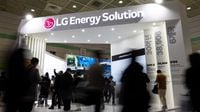LG Energy Solution, one of South Korea’s leading battery makers, is set to resume its U.S. business trips after a significant breakthrough in visa negotiations between the South Korean and American governments. This development, reported on October 2, 2025, has far-reaching implications for both the electric vehicle (EV) industry and the ongoing economic partnership between the two allies.
According to Investing.com, LG Energy Solution (LGES) announced Thursday it would gradually restart business trips for its employees and subcontractors to the United States, following an agreement resolving recent visa issues. The company plans to begin these trips after the Chuseok thanksgiving holiday, which runs from October 3 to October 9, starting with key personnel who are essential for the acceleration of construction and operations at LGES’s U.S. factory.
This move comes on the heels of a tense episode last month, when U.S. immigration officials raided a joint plant construction site shared by LGES and Hyundai Motor in Georgia. During that operation, hundreds of South Korean workers were arrested, a development that both surprised and alarmed the South Korean government and public. The workers were eventually released after a week of intense negotiations between South Korean and U.S. officials, as reported by Investing.com and confirmed by statements from both governments.
The incident highlighted a longstanding issue: the lack of access to the appropriate class of U.S. visas for specialized South Korean workers needed at investment sites. In response, the two governments convened a working group to address the matter and prevent similar disruptions in the future. According to South Korea’s foreign ministry, the United States has now agreed to allow South Koreans to work at U.S. investment sites—installing, servicing, and repairing equipment—under existing temporary visas. Additionally, a new visa section dedicated to South Korean businesses will be established at the U.S. embassy in Seoul, and new channels for visa coordination will be opened between U.S. immigration authorities and South Korean missions.
While these measures mark a step forward, the U.S. side made it clear that more fundamental changes to the visa system—such as creating or expanding visa categories for skilled South Korean workers—face significant legislative hurdles. According to South Korea’s foreign ministry, “practical legislative constraints” have hampered progress on a bill that would grant clearer and more certain access for these specialty workers. The bill has struggled in Congress, largely because visa policy is so closely intertwined with the broader, and often contentious, debate over immigration in the United States.
Despite these constraints, U.S. officials have reiterated their commitment to fostering investment partnerships. Deputy Secretary of State Christopher Landau, speaking at the working group’s first meeting in Washington, emphasized the “critical role” played by skilled workers from South Korean companies investing in the United States. The State Department echoed this sentiment, stating that the U.S. remains committed to encouraging investment by South Korean firms, which are among the country’s leading foreign investors.
The stakes are high for both sides. For South Korea, ensuring its workers can access and support major projects in the U.S. is crucial for companies like LGES and Hyundai Motor, which have made substantial investments in American manufacturing. For the United States, these investments are key to advancing the domestic EV industry, creating jobs, and maintaining a competitive edge in the global green technology race.
The recent visa agreement is expected to accelerate construction and operational timelines at LGES’s U.S. factory. According to AFP, with the visa issue now moving toward resolution, LGES is poised to ramp up its activities and reinforce its role in supplying batteries for the burgeoning American EV market. This is especially timely, as the demand for electric vehicles continues to soar and the U.S. government pushes for greater domestic production of EV components.
Yet, the industry faces its own set of challenges. Ford CEO Jim Farley recently warned that EV sales could fall by half without federal credits, underscoring the delicate balance between government incentives and market demand. However, some dealers are reportedly eager to see how these products perform without the cushion of federal incentives, suggesting there’s still plenty of confidence in the underlying technology and consumer interest.
Meanwhile, the U.S. government’s approach to South Korean workers reflects a broader tension: a desire to attract foreign investment and maintain strong economic ties, while also navigating domestic pressures around immigration policy. The new visa channels and embassy section are practical steps, but the lack of more sweeping reform leaves some uncertainty for companies that rely on specialized foreign labor.
In the aftermath of the Georgia raid, both governments have shown a willingness to collaborate and find interim solutions, even as deeper legislative changes remain elusive. The working group set up to address these issues will continue to meet, signaling that the conversation is far from over. According to South Korea’s foreign ministry, further meetings are planned to “better coordinate visa matters” and ensure that the needs of both countries’ businesses are met.
For LG Energy Solution, the ability to resume U.S. business trips is more than just a bureaucratic victory—it’s a critical step toward fulfilling its ambitious plans in the American market. The company’s phased approach, starting with key personnel after the Chuseok holiday, reflects both caution and optimism as it looks to rebuild momentum after the recent disruption.
The broader context is one of deepening economic interdependence between South Korea and the United States. South Korean firms have become major players in the U.S. manufacturing landscape, particularly in sectors like batteries and electric vehicles that are seen as vital to the future of both economies. The resumption of business trips and the establishment of new visa channels are tangible signs of progress, even if the path to comprehensive visa reform remains complicated.
As the dust settles from last month’s immigration raid and the new visa procedures take effect, all eyes will be on how quickly LG Energy Solution and its partners can get back on track. The outcome will not only shape the fortunes of a handful of companies, but will also serve as a barometer for the broader U.S.-South Korea investment relationship in an era of rapid technological change and shifting global alliances.
For now, the message from both sides is one of cautious optimism: the road ahead may have its bumps, but the engines of cooperation are running once again.

